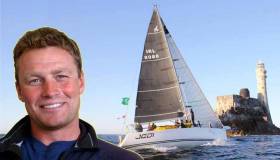Displaying items by tag: Offshore Racing
More Young Sailors Going Offshore is an Encouraging Trend - SCORA's Daragh Connolly
More young sailors are interested in racing offshore, an encouraging trend that should be fostered. It can help to bridge the problems that have been encountered in sailing where younger sailors have been lost to the sport in bridging the gap from dinghy to cruiser racing.
Younger sailors have been featuring more in South Coast racing and are included on the crews of leading Cork boats.
The newly-elected Commodore of the South Coast Offshore Racing Association (SCORA), Daragh Connolly, sees this as a particularly positive and encouraging trend.
 Daragh Connolly, the new Commodore of SCORA. Listen to him on the podcast below Photo: Bob Bateman
Daragh Connolly, the new Commodore of SCORA. Listen to him on the podcast below Photo: Bob Bateman
 Noel Coleman's Blue Oyster is registered for August's Fastnet Race Photo: Bob Bateman
Noel Coleman's Blue Oyster is registered for August's Fastnet Race Photo: Bob Bateman
"I cut my teeth in coastal, offshore racing. It is an exciting part of the sport and I'm encouraged and very positive about this. It is part of the renewed and growing interest in coastal racing," he says in this week's podcast, where he also talks about liaising with ISORA, the successful 450 Dun Laoghaire to Cork Race and the three south coast yachts which have entered for the Fastnet Race.
 Denis and Annamarie Murphy's Nieulargo from Royal Cork was the winner of the inaugural Fastnet 450 Race and will compete in August's Fastnet Race Photo: Bob Bateman
Denis and Annamarie Murphy's Nieulargo from Royal Cork was the winner of the inaugural Fastnet 450 Race and will compete in August's Fastnet Race Photo: Bob Bateman
There are two boats from his own club and one from that of the new Vice-Commodore of SCORA, Dave Cullinane from Kinsale YC. From the RCYC - Noel Coleman's Blue Oyster and Denis/Annemarie Murphy's Nieulargo. From Kinsale Cian McCarthy's Cinnamon Girl.
 Cian McCarthy's Sunfast 3300 Cinnamon Girl from Kinsale Yacht Club is entered as a 'double-hander' for August's Fastnet Race Photo: Bob Bateman
Cian McCarthy's Sunfast 3300 Cinnamon Girl from Kinsale Yacht Club is entered as a 'double-hander' for August's Fastnet Race Photo: Bob Bateman
"For the season ahead, perhaps offshore could start on the Cork coast even if with restricted crewing. More racing outside Cork Harbour will be a positive experience for SCORA boats and challenging. The entry of 21 boats for last year's Navy Race, which was switched from inside to outside the harbour due to the Covid situation, showed the interest and that included white sail as well as spinnaker. There is a positive role here for more development and I am positive and hopeful. Despite the challenges which we face from Covid which has impacted so much on sailing, as soon as we have the clearance to go, you can be sure that SCORA will be there and ready. Despite the difficulties and challenges, I am positive for the future. We have a good team in place at SCORA and will carefully plan for the season ahead, allowing for the restrictions and limitations in place at present."
Listen to the podcast below
SCORA AGM to Hear of Demand for Offshore Racing on South Coast
"Offshore racing and club inclusion" will be the main themes for South Coast Offshore Racing Association (SCORA) in the year ahead according to the Commodore of SCORA prior to its annual general meeting which will be held this Thursday night.
Commodore, Johanna Murphy, says that there is a big demand for racing offshore and this will be an important part of the future focus for sailing on the south coast.
She has called this year's agm for Thursday and, like most such meetings during the present pandemic, it will be on Zoom.
The structure of the Association will move to appoint a Commodore, Vice-commodore, Sailing Secretary and Treasurer, bringing more people into the organisation and strengthening its administration.
The outgoing Commodore, having completed her term in office, will not be going forward for re-election, but said that the focus of SCORA should increase concentration on the inclusion of all clubs on the South Coast.
There will be an annual gathering, she said, which will, when the pandemic allows, increase the social contact of sailors along the coast and the promotion of the sport.
The AGM will start at 8 p.m. Members are invited to join the Zoom meeting here
Tonight at the INSS: From Sailing an Optimist to an Offshore Racing Yacht & Running a Sailing School
As part of the Irish National Sailing School 40th Birthday Celebrations the country's leading sailing school is hosting a series of free talks and events starting tonight when School Principal Kenneth Rumball will share tales about his background and the pursuit of his hobby including the story of the 2017 Rolex Fastnet Race Campaign and how the lessons learned can be used to encourage more people to try sailing in Ireland.
One of the topics Rumball will cover will be the inside story of the INSS's 2017 Fastnet Race Campaign.
Rumball will chat about his dinghy sailing and youth racing which was where he learned his skills. This section of the talk will be of particular interest to parent of young sailors who may like to get involved in this in the future.
The final section of the talk will deal with what is involved with running the largest training centre in Ireland and the UK and some of our plans for the future. We've a few new announcements planned for those in attendance!
The talk is open to all, please do let INSS know if you're coming along, by email to [email protected] or pop along to the INSS centre on the West Pier at 8pm today March 14th 2018.






























































